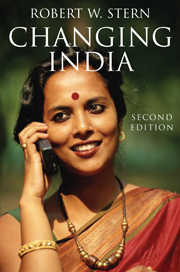Book contents
- Frontmatter
- Contents
- List of maps and tables
- Preface to the second edition
- Glossary
- Introduction: Change, the societies of India and Indian society
- Part I The changing countryside
- Part II Change from above
- 5 British imperialism, Indian nationalism and Muslim separatism
- 6 The Indian Union in a changing India
- Appendix One Major political events in the related histories of British imperialism and Indian nationalism, 1858–1947
- Appendix Two Major political events in the history of the Indian Union, 1947–2002
- Notes
- Guide to further reading
- Index
6 - The Indian Union in a changing India
Published online by Cambridge University Press: 18 April 2011
- Frontmatter
- Contents
- List of maps and tables
- Preface to the second edition
- Glossary
- Introduction: Change, the societies of India and Indian society
- Part I The changing countryside
- Part II Change from above
- 5 British imperialism, Indian nationalism and Muslim separatism
- 6 The Indian Union in a changing India
- Appendix One Major political events in the related histories of British imperialism and Indian nationalism, 1858–1947
- Appendix Two Major political events in the history of the Indian Union, 1947–2002
- Notes
- Guide to further reading
- Index
Summary
In general terms, and with variable consistency and success, Indian governments have pursued two major policy goals: political and economic development. “Democracy” and “secularism” are at once the officially designated means of political development and its desired ends. Democratic and secular political development is meant to produce a democratic and secular political culture. Corruption is not meant to be there at all. But it is. With parliamentary democratic development and Indian secularism, it is a subject of this chapter's first section. My discussion of industrial development and the educated and modern business middle classes follows in the second section. As the once-officially designated means to industrial development, “socialism” was never much more than a slogan. Nothing much remains of it today other than a large and varied public sector menagarie of industrial white elephants. Not socialism, but private and state capitalism have developed together with parliamentary democracy in India. Together they have produced an officially sponsored, subcontinental variant of bourgeois revolution.
My third section deals with India's international politics. These are connected to bourgeois revolution in India: partially and as elsewhere, an external manifestation of things domestic. But to approach India's international politics by way of bourgeois revolution would probably strain the concept beyond its limits.
Political change: parliamentary democracy, political corruption and India as a secular state
Led for all but three of the Union's 42 years to 1989 by three generations of the Nehru-Gandhi dynasty, India's governing party from its independence was Congress.
- Type
- Chapter
- Information
- Changing IndiaBourgeois Revolution on the Subcontinent, pp. 171 - 216Publisher: Cambridge University PressPrint publication year: 2003



